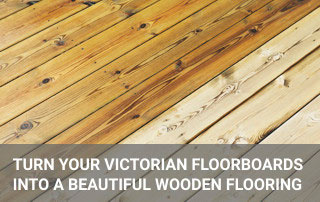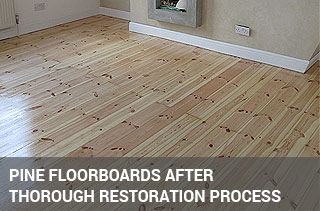Back to DIY Advice
Pine Floorboards Sanding - DIY Guide

Sanding pine floorboards is an essential step in maintaining their beauty and durability. Over time, wooden floors can become worn, scratched, or uneven, diminishing their aesthetic appeal and structural integrity. Proper sanding removes old finishes, smooths out imperfections, and prepares the surface for refinishing, ultimately extending the lifespan of the floor.
While professional sanding services are highly recommended due to their expertise, efficiency, and access to advanced equipment, some homeowners may prefer the DIY approach to save costs. However, floor sanding is a delicate and time-consuming process that requires precision and patience. Mistakes such as uneven sanding, over-sanding, or improper sealing can lead to costly repairs. If you are confident in your abilities and willing to invest the necessary time and effort, a DIY floor sanding project can be a rewarding experience.
Preparation Before Sanding
Before beginning the sanding process, proper preparation is essential to ensure a smooth and professional-looking result. Taking the time to gather the right tools and prepare the floor correctly will make the process more efficient and help avoid common DIY mistakes.
Renting the Right Equipment
Sanding pine floorboards requires specialised equipment to achieve an even and polished finish. The two essential machines for this task are:
- Belt Sander – Used for sanding the main surface of the floor, removing old finishes, and smoothing out imperfections. This powerful tool ensures uniform sanding across large areas.
- Edger or Orbital Sander – Designed for sanding corners, edges, and other hard-to-reach areas that the belt sander cannot effectively cover. This tool is crucial for achieving a consistent finish across the entire floor.
Step-by-step guide to using an orbital floor sander
Renting high-quality sanding equipment from a home improvement store ensures better results and saves time compared to using lower-quality or manual tools.
Choosing the Right Sandpaper Grits
Selecting the correct sandpaper grits is vital for gradually refining the surface of the floor. Sanding should be done in progressive stages, starting with a coarser grit and finishing with a finer one:
- 40 Grit (Coarse) – Used for the initial sanding to remove old finishes, deep scratches, and imperfections.
- 60 Grit (Medium) – Helps smooth out the rough surface left by the coarse sanding.
- 80 Grit (Fine) – Further refines the floor, preparing it for finishing.
- 120 Grit (Very Fine) – Provides a smooth, polished surface, ensuring the floor is ready for staining or sealing.
Preparing the Floor
A well-prepared floor makes sanding more effective and prevents potential damage to the equipment or the wood. Follow these essential steps before starting the sanding process:
- Remove Baseboards and Trims – Use a trim pry bar to detach baseboards carefully. Label each piece to ensure easy reinstallation once the sanding and finishing are complete.
- Check for Protruding Nails or Screws – Walk over the floor and inspect for any raised nails or screws that could damage the sanding machine. Secure them back into place to create a level surface.
- Fill Small Gaps – Use a solvent-based resin to fill minor cracks or gaps between the boards, ensuring a seamless finish.
- Fill Larger Gaps – For wider gaps, insert thin wood strips that match the color and grain of the floorboards. This prevents dirt accumulation and improves the overall appearance.
Taking these preparatory steps will set the foundation for a successful sanding project, making the process smoother and more effective.
Safety Precautions

Wood floor sanding generates a significant amount of dust and requires the use of powerful machinery, making safety a top priority. Taking the right precautions will protect you from potential hazards and ensure a smooth sanding process.
- Wear Safety Glasses and a Dust Mask – Sanding produces fine wood particles that can irritate your eyes and respiratory system. Always wear safety glasses to protect your eyes and a dust mask or respirator to prevent inhaling harmful dust.
- Ensure Good Ventilation – Proper airflow helps reduce dust accumulation and keeps the workspace comfortable. Open windows and doors where possible, and consider using fans or a dust extraction system if available.
- Handle Sanding Machines with Care – Floor sanders are powerful tools that require controlled movement. Avoid pressing too hard or keeping the machine in one spot for too long, as this can cause uneven sanding or damage the wood. Always follow the manufacturer’s instructions to ensure safe operation.
By following these safety precautions, you can minimise risks and create a safer working environment while achieving professional-quality results.
Step-by-Step Sanding Process
Sanding pine floorboards requires a systematic approach to achieve a smooth and even surface. Following a progressive sanding sequence ensures that all imperfections are removed, and the floor is properly prepared for finishing.
1. Initial Sanding (40 Grit)
The first sanding pass is crucial for removing old finishes, deep scratches, and uneven areas.
- Fit the belt sander (for large areas) or orbital sander (for smaller rooms) with 40-grit sandpaper.
- Begin sanding in the direction of the wood grain to prevent scratches and uneven marks.
- Avoid applying excessive pressure or lingering too long in one spot, as this can create dips or gouges in the wood.
2. Edge Sanding
Since the main sander cannot reach the edges of the room, an edger or orbital sander is necessary for sanding corners and tight spaces.
- Use an edger sander fitted with 40-grit sandpaper to sand along walls, corners, and other hard-to-reach areas.
- Maintain consistent movement to ensure even sanding and avoid leaving visible marks.
- Take care not to over-sand the edges, as this can create a noticeable difference in height between the edges and the main floor area.
3. Progressive Sanding (60, 80, and 120 Grits)
To refine the floor surface, sanding must be done in multiple stages using progressively finer grits.
- Repeat the sanding process with 60-grit sandpaper to smooth out rough patches left by the initial sanding.
- Follow with 80-grit sandpaper to further refine the surface, ensuring an even texture.
- Finish with 120-grit sandpaper to achieve a smooth, polished look, ready for staining or sealing.
- After each sanding pass, vacuum the floor thoroughly to remove dust and debris. This prevents scratches and ensures a clean surface for the next grit level.
By following this step-by-step process, you will achieve a professional-quality finish, setting the stage for the final refinishing steps.
Finishing the Floor

Once the sanding process is complete, the next step is to properly clean and finish the floor to enhance its durability and appearance. This stage involves thorough cleaning, staining or painting, and applying a protective sealant to ensure long-lasting results.
1. Vacuuming and Cleaning the Surface
Before applying any finish, it's crucial to remove all dust and debris to achieve a flawless result.
- Use a high-powered vacuum to remove all traces of dust from the floor, paying close attention to edges and corners.
- Wipe the floor with a slightly damp microfiber cloth to pick up any remaining fine particles.
- Allow the floor to dry completely before proceeding to the next step.
2. Applying the Stain or Paint
Staining or painting the floor enhances the natural beauty of the wood or adds a desired color tone.
- Choose a stain or paint that complements the pine wood and aligns with your interior design.
- Apply the product in the direction of the wood grain using a lint-free cloth, brush, or applicator pad.
- Wipe off excess stain or paint immediately to ensure an even and uniform finish.
- Allow the stain or paint to dry fully before proceeding to sealing.
3. Applying the Protective Finish
A protective finish is essential to safeguard the floor against wear, moisture, and damage.
- Select a semi-gloss, matt, or satin sealant depending on your preferred aesthetic.
- Use a medium-pile roller for even application, ensuring smooth coverage.
- Allow the first coat to dry completely, then sand lightly with 150-grit sandpaper to enhance adhesion.
- Vacuum the floor and apply additional coats as recommended by the manufacturer, repeating the light sanding between each coat.
Additional Tips for a Professional Look
To achieve a flawless, high-quality finish, attention to detail is key. Here are some expert tips to ensure the best results for your pine floorboards:
-
Check for Uneven Areas After Sanding – Run your hand over the surface and inspect the floor under good lighting to spot any rough or uneven spots. If needed, lightly sand those areas for a uniform finish.
-
Avoid Over-Sanding – Sanding too much can thin out the floorboards, making them weaker and prone to damage. Stick to the recommended sanding grit sequence and avoid excessive pressure.
-
Allow Proper Drying Time for All Finishes – Rushing the drying process can lead to a patchy or sticky finish. Always follow the manufacturer’s drying recommendations between coats of stain, paint, and sealant.
-
Maintain Your Floor Regularly – To keep your newly sanded floor in top condition:
- Sweep or vacuum frequently to prevent dust buildup.
- Use furniture pads to protect against scratches.
- Clean with a wood-friendly floor cleaner and avoid excess moisture.
- Reapply a protective coat every few years to maintain durability.
Sanding and refinishing pine floorboards can be a rewarding DIY project if done correctly. By following the key steps—preparing the floor, using the right sanding techniques, progressively smoothing the surface, and applying a protective finish—you can restore the natural beauty of your wooden floors while ensuring durability.
However, if you encounter issues such as deep scratches, uneven boards, or structural damage, or if you simply want a flawless, professional result without the hassle, hiring a professional floor sanding company is always a great option. Experts have the experience and specialised equipment to achieve a superior finish with minimal risk.
Now that your pine floorboards are beautifully restored, take the time to enjoy the warmth and character they bring to your home. With proper care and maintenance, your floors will continue to enhance your space for many years to come.